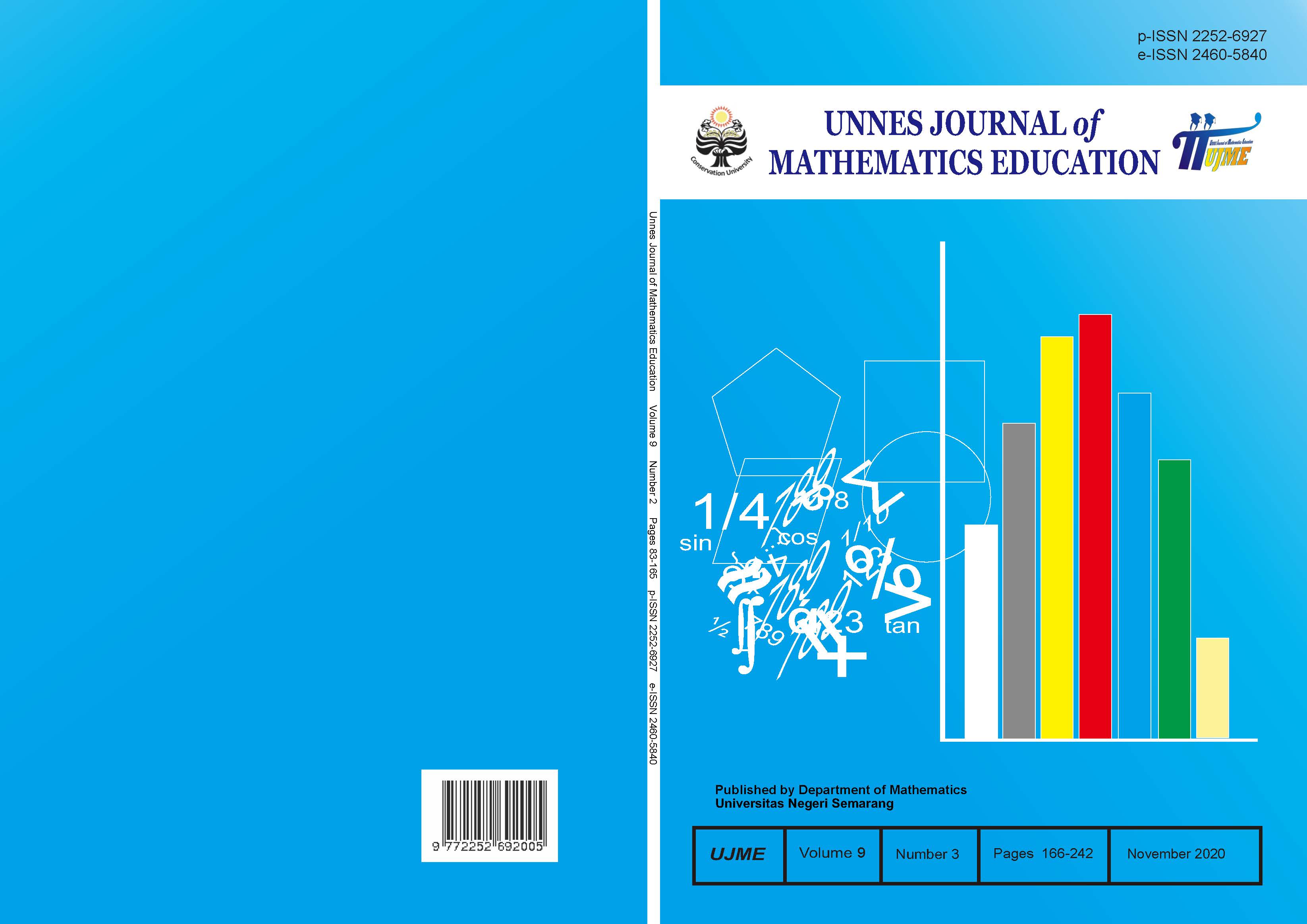The analysis of mathematical connections ability reviewed from student’s curiosity in themed problem based learning
##plugins.themes.academic_pro.article.main##
Abstract
The purpose of this study was to determine the types of errors and causes of student errors in terms of the Newman procedure in solving open-ended questions on geometry and to determine the quality of learning using the contextual-based Treffinger model and achieving classical completeness. This research is a mix methods research. The design used in quantitative research is the Pre-Experimental Design with the type of One-Shot Case Study Design.The population in this study was 8th grade of JHS Muhammadiyah 8 Semarang with a sample of 8th U1 grade. Six students were selected as research subject. The data were taken by observation, interview, test and analyzed by using classical and descriptive qualitative learning mastery test. The results showed that an error in understanding the problem was carried out by one subject in the medium group and all subjects in the lower group, a transformation error was carried out by one subject in each group, an error in processing ability was carried out by all subjects in the upper group and one subject in the medium or medium group, then writing errors were made by all subjects in the upper group and one subject in the medium group. The cause of misunderstanding the problem is that students do not understand the problems listed on the questions. The cause of the transformation error is that students do not know the strategy used. The cause of processing ability errors is that students cannot determine the calculation correctly. Writing errors were caused by students not being careful in writing answers. The quality of learning in the contextual-based Treffinger model and the students' ability to solve open-ended questions on geometry using the contextual-based Treffinger model achieve classical learning completeness.
##plugins.themes.academic_pro.article.details##
References
Aspuri, & Pujiastuti, A. 2019. Kemampuan Koneksi Matematis Siswa SMP dalam Menyelesaikan Soal Cerita: Studi Kasus di SMP Negeri 3 Cibadak. Jurnal Ilmiah Pendidikan Matematika. 7(2): 124-131.
Belecina, R. R., & Ocampo Jr, J. M. 2016. Mathematical Curiosity, Epistemological Beliefs, and Mathematics Performance of Freshman Preservice Teachers. MIMBAR PENDIDIKAN. 1(1): 123-136.
Geni, P. R. L., & Hidayah, I. 2017. Kemampuan Pemecahan Masalah Siswa pada Pembelajaran Problem Based Learning Bernuansa Etnomatematika Ditinjau dari Gaya Kognitif. Unnes Journal of Mathematics Education Research. 6(1): 11-17.
Handal, B & Bobis, J. 2004. Teaching Mathematics Thematically: Teachers’ Perspectives. Mathematics Education Research Journal, 16(1): 3-18.
Haji, S. 2015. Pembelajaran Tematik yang Ideal di SD/MI.MODELING. Jurnal Program Studi PGMI. 2(1): 56-69.
Istikomah, F., Rochmad, R., & Winarti, E. R. 2017. Analysis of 7th Grade Students’ Inductive Reasoning Skill in PBL Bertema Model Towards Responsibility Character. Unnes Journal of Mathematics Education. 6(3): 345-351.
Kemendikbud. 2013. Model Pembelajaran Berbasis Masalah (Problem Based Learning).
Kurniasih, A.W. 2012. Scaffolding sebagai Alternatif Upaya Meningkatkan Kemampuan Berpikir Kritis Matematika. Jurnal KREANO. 3(2): 113-124.
Latif, S., & Akib, I. 2016. Mathematics Connection Ability in Solving Mathematics Problem Based Abilities of Students at SMPN 10 Bulukumba. Jurnal Daya Matematis. 4(2): 207-217.
Min, K. C., Abdullah, M.R., & Mohd, I.N. 2012. Teachers’ Understanding and Practice Towards Thematics Approach in Teaching Integrated Living Skills (ILS) in Malaysia. International Journal of Humanities and Social Science. 2(23): 273-281.
Padmavathy, R. D., & Mareesh, K. 2013. Effectiveness of Problem Based Learning In Mathematics. International Multidisciplinary e-Journal. 2(1): 45-51.
Prasetyo, A., Dwiyati, N. K., Junaedi, I. 2017. Students’s Mathematics Connection Ability and Disposition Reviewed by Keirsey Personality Type through Eliciting Mathematics Learning Model. Unnes Journal of Mathematics Education. 5(3): 218-226.
Rifa’i, A., & Anni, C. T. 2012. Psikologi Pendidikan. Semarang: Universitas Negeri Semarang.
Romli, M. 2016. Profil Koneksi Matematis Siswa Perempuan SMA dengan Kemampuan Matematika Tinggi dalam Menyelesaikan Masalah Matematika. Journal of Mathematics Education, Science and technology. 1(2): 144-163.
Rusman. 2015. Pembelajaran Tematik Terpadu: Teori, Praktik dan Penilaian. Jakarta: Rajawali Pers.
Sanjaya, W. 2011. Strategi Pembelajaran Berorientasi Standar Proses Pendidikan. Jakarta: Kencana Prenada Media Group.
Saputro, D.A., Masrukan, & Agoestanto, A. 2017. Analisis Kemampuan Penalaran Induktif Siswa Kelas VII pada Model Pembelajaran PBL Bertema Ditinjau dari Karakter Tanggung Jawab. Unnes Journal of Mathematics Education, 6(2): 239-248.
Setyaningsih, L., Asikin, M., & Mariani, S. 2016. Analisis Kemampuan Koneksi Matematika Siswa Kelas VIII pada Model Eliciting Activities (MEA) Ditinjau dari Gaya Kognitif. Unnes Journal of Mathematics Education. 5(3): 218-226.
Shoimin, A. 2014. 68 Model Pembelajaran Inovatif Dalam Kurikulum 2013. Yogyakarta: Ar-Ruzz Media.
Yahya, MOF. 2015. Manajemen Implementasi Kurikulum dan Proses Pembelajaran. Tarbiyah Islamiyah. 5(2): 119-131.
